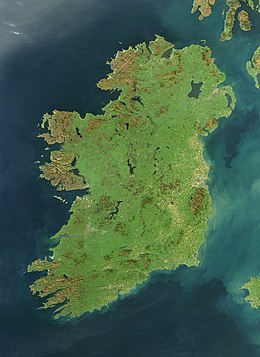 | |
| Continent | Europe |
|---|---|
| Region | Northwestern Europe |
| Area | |
| • Total | 84,421 km2 (32,595 sq mi) |
| • Land | 98.2% |
| • Water | 1.8% |
| Coastline | 7,524 km (4,675 mi) |
| Highest point | Carrauntoohil 1,039 metres (3,409 ft) |
| Lowest point | North Slob −3 metres (−10 ft) |
| Longest river | River Shannon 360.5 km (224.0 mi) |
| Largest lake | Lough Neagh 392 km2 (151 sq mi) |
| Climate | temperate oceanic climate with some upland areas classified as oceanic subpolar |
| Terrain | flat, low-lying area in the midlands, ringed by mountain ranges |
| Natural resources | aquaculture, fertile soil, freshwater, timber, peat, bauxite, copper, zinc, lead, gold, silver, iron, gypsum, natural gas, hydropower, wind energy |
| Natural hazards | Cyclones, flooding, thunderstorms |
| Environmental issues | Water pollution, Leaching, Climate change, Waste disposal |
Ireland is an island in Northern Europe in the north Atlantic Ocean. The island, of up to around 480 km (300 mi) north-south, and 275 km (171 mi) east-west, lies near the western edge of the European continental shelf, part of the Eurasian Plate. Its main geographical features include low central plains surrounded by coastal mountains. The highest peak is Carrauntoohil (Irish: Corrán Tuathail), which is 1,039 metres (3,409 ft) above sea level. The western coastline is rugged, with many islands, peninsulas, headlands and bays, while the southern and northern coasts feature a smaller number of substantial sea inlets, such as Lough Foyle and Cork Harbour; no part of the land is more than around 110 km (68 mi) from the sea. It was administratively divided into 32 counties, gathered in 4 provinces, though current arrangements, especially in Northern Ireland, differ from this model. The island is almost bisected by the River Shannon, which at 360.5 km (224 mi) with a 102.1 km (63 mi) estuary is the longest river in Ireland and flows south from County Cavan in the province of Ulster to form the boundary between Connacht and Leinster, and later Munster, and meet the Atlantic just south and west of Limerick. There are a number of sizeable lakes along Ireland's rivers, of which Lough Neagh is the largest.
Politically, the island consists of the Republic of Ireland, with jurisdiction over about five-sixths of the island, and Northern Ireland, a constituent part of the United Kingdom, with jurisdiction over the remaining sixth. Located west of the island of Great Britain, Ireland lies at approximately 53°N 8°W / 53°N 8°W. It has a total area of 84,421 km2 (32,595 sq mi)[1] and is separated from Great Britain by the Irish Sea, bounded to the north and south respectively by the North Channel and St George's Channel, and from mainland Europe by the Celtic Sea. Ireland forms the second largest landmass in the British Isles, together with Great Britain and the Isle of Man.[2][3]
The island has a temperate oceanic climate, mild and humid, and is warmer than other landmasses at the same latitude due to its position vis-a-vis the winds on the Atlantic Ocean, and ocean currents and circulations. The island is one of the least forested areas in Europe, though afforestation is growing, but has a strong agricultural sector. It has a limited range of mineral resources, and has only had two major gas finds, and none in the oil sector. Hydroelectric energy is actively used, and wind farms are extending; neither solar nor tidal energy is as yet much exploited.
- ^ Nolan, Professor William. "Geography of Ireland". Government of Ireland. Archived from the original on 24 November 2009. Retrieved 15 October 2009.
- ^ Ryan, Nicky (28 October 2013). "Complex politics or simple geography: Is Ireland part of the British Isles?". TheJournal.ie. Retrieved 26 January 2021.
- ^ Davies, Alistair; Sinfield, Alan (2000), British Culture of the Postwar: An Introduction to Literature and Society, 1945–1999, Routledge, p. 9, ISBN 978-0-415-12811-7,
Many of the Irish dislike the 'British' in 'British Isles', while the Welsh and Scottish are not keen on 'Great Britain'. ... In response to these difficulties, 'Britain and Ireland' is becoming preferred usage although there is a growing trend amounts some critics to refer to Britain and Ireland as 'the archipelago'.